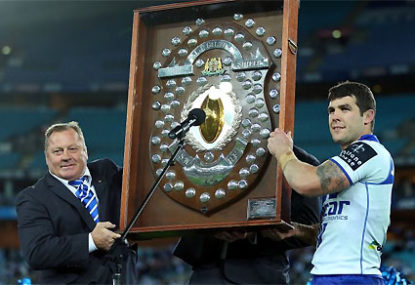Fans give Tigers' Alex Seyfarth a big spray after headbutt that resulted in double sin-binning
The Tigers finished the game with 11 men after David Klemmer was sent for ten minutes for dissent, and following a fracas, Seyfarth was…

Full disclosure, readers: I tipped South Sydney to defeat Canterbury on Saturday night. I felt Canterbury were ripe for the picking if Souths were able to get a roll on early.
We’ll never know if my prediction would have come true had Adam Reynolds been able to retain use of both hamstrings. Having watched the ‘Dogs over the 80 minutes, however, I have to confess I doubt it.
So how to defeat Canterbury? With great difficulty. Des Hasler’s use of his forwards as ball-playing pivots before the line has been well documented.
What is brand new in my lifetime is how Canterbury has in essence combined first and second phase play when using the football, due to the freakish speed and evasion of its outside men.
Time and again on the weekend it seemed as if Canterbury were hitting the ball up conventionally with a one-out run, before suddenly sending two attackers and a decoy loose on the edges, almost from a standing start.
Ben Barba would burst behind a decoy with Josh Morris or Krisnan Inu waiting to connect with their winger and before you blinked, play had advanced 40 metres down the field.
This is almost impossible to defend. Up until now, 14 other teams in the competition have settled for a one tackle/one shape approach when running the football – either a conventional, direct attack using big power runners up the middle who then might seek to offload, or spreads involving those big men as decoys for the speed men coming up behind them.
Canterbury have fused the two, meaning that any time the defence compresses to contain men like Sam Kasiano, Greg Eastwood and Frank Pritchard, the Bulldogs’ attack suddenly morphs into a set piece on the edges. All within the same play. If the defence slides in anticipation of a spread, those same big men hold onto the ball and roll the defensive line backwards.
Hasler has realised that with enough precision his team doesn’t need the entire width of the field or three decoys and five ball runners to drop into attacking structures. His attack is changeable, able to respond to the opportunities that appear in the moment and adjust its focal point.
So how to defend this? I’m betting Craig Bellamy has his Storm players running drills constantly this week – collapsing and expanding/sliding with equal precision and intent.
Melbourne must read Canterbury’s big men; if Kasiano/Pritchard float laterally, Melbourne must slide with them, inviting them to pass.
As soon as Canterbury’s big men straighten in attack, the Storm forwards have to commit and bend them back, doing whatever it takes to prevent offloads.
I mentioned that the other 14 teams tend to play more conventionally than Canterbury in attack (probably by necessity). Luckily for league fans, the one team able to match Canterbury in deadly precision and fluidity in attack is the Storm, who have proven to be equally difficult to defend.
The Storm possess the greatest attacking combination in the middle corridor of the field in rugby league history, that of Smith/Cronk/Slater. Smith and Cronk’s ability to change direction and hit Slater with bullets at full speed has never been seen before. When executed well on the back of powerful forward runs, it is almost impossible to stop.
Combine this with structures that can sometimes involve almost the entire team moving at full speed in perfect synchronicity, and it often doesn’t matter how committed the defence is; Bellamy is asking an opposition defensive line to make five or six perfect reads on one play. Too much to ask, much of the time.
So how to defend against the Storm?
Physical intimidation will be key for Canterbury: they must be prepared to give a little on the edges in order to dominate in tight.
The Bulldog players defending the center have to trust their edge defenders’ speed and ability to slide, in order to shut down the middle. The Bulldogs must take a risk; they will have to compress around the play-the-ball in order to close down that middle third of the field.
Cameron Smith and Cooper Cronk are not nearly as effective when forced to ball-play against smaller, more agile defenders on the fringe. Canterbury must force them to look for openings wider out. The Bulldogs must then trust their overall superiority in attack across their entire team to prevail over eighty minutes.
Rugby league is a simple game; in the modern era, it is usually dominated by the teams able to play with greatest complexity.
We’ve got the two best representatives of the modern game in our grand final.
After much consideration, I’m tipping Melbourne, because I like purple…